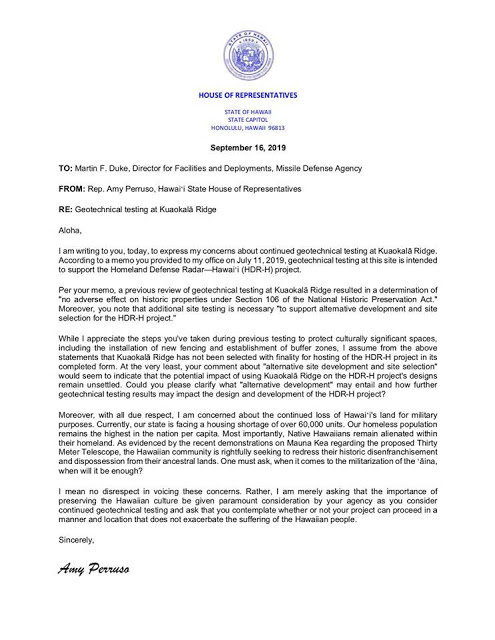Summary: The Pentagon is planning to build a billion dollar radar system called the Homeland Defense Radar Hawaii (HDR-H) on Oahu, Hawaii, to track incoming ballistic nuclear missiles as a part of the US Missile Defense system. A preliminary Environmental Impact Statement(EIS) names two possible locations for the 8-story-tall-by-8-story-wide radar station that would take up approximated 160-acres of land: Kuaokala Ridge, adjacent to the Kaena Point Satellite Tracking Station(KPSTS) which is used for tracking satellites and space debris, and two possible sites in the Kahuku Training Area(KTA) on the North shore.
An Archeological Survey of the Kauokala Ridge required by The National Historic Preservation Act(NHPA) conducted by Keala Pono Consulting Firm, identified several sites that are of historical and cultural significance in the proposed locations including the Moka'ena Heiau located on the highest elevation on Kaena point. However, scientific organizations such as The Bulletin of Atomic Scientists and Union of Concerned Scientists(UCS) have recently claimed that missile defense has a poor testing track record and is ineffective to protect the US homeland. The final EIS is due in 2020 with construction slated to begin in 2021.
Billion Dollar Expansion of Missile Defense in Hawaii and the PacificThe 2017 National Defense Authorization Act required the Missile Defense Agency(MDA) to develop and field a "discrimination radar" to improve the defense of Hawaii from ballistic missile threats. "Discrimination" refers to the ability to distinguish actual warheads from rocket debris, countermeasures and decoys, which, according to the Union of Concerned Scientists(UCS), such radar systems are not capable of doing and have never been tested for under real life scenarios.
The HDR-H would be used to support missile defense systems at the Pacific Missile Range Test Facility(PMRF Barking Sands) on the west side of Kauai that houses an Aegis "Ashore" Ballistic Missile Defense System(Aegis BMD). Although the Aegis Ashore system is not currently "deployed" on Kauai for use in warfare, the Pentagon is pushing to "operationalize" it. PMRF also houses a Terminal High Altitude Area Defense System(THAAD) used to defend against incoming short and medium range missiles possibly from North Korea or China.
Proposed Locations for Radar Construction and DevelopmentThe Department of Defense announced the intention to build the HDR-H June 1, 2018 and initiated a scoping process for determining potential sites in Hawaii. The preliminary EIS states that if the Kuaokala Ridge site is selected for HDR-H, existing facilities at KPSTS such as the Solar Electro-Optical Observatory would be blocking the radar's view and would have to be relocated. Additional infrastructure development would also be required.
The Hawaiian State Legislature proposed a bill (H.B N0. 1396) in 2019 to assist providing the tremendous amounts of energy required for HDR-H with renewable energy sources. The bill is in committee for further action when the legislature reconvenes next year.
Sacred Hawaiian Sites on Proposed Radar LocationsAn Archeological Survey of the Kauokala Ridge required by The National Historic Preservation Act(NHPA) conducted by Keala Pono Consulting Firm, identified Moka'ena Heiau in the Area of Potential Effect (APE) and recommended that it be registered with both the National and Hawaii Register of Historic Places. The survey also recommended protecting the Moka'ena Heiau (site 188) with a buffer zone and that access should be made available to the heiau for cultural practitioners and other interested community members.
Kaena Point on Kuaokala Ridge has both cultural and historical significance to the Hawaiian people, and is the site of several sacred sun and wind Heiaus, as described in the Archeological Survey. Historically, it was where the prophet Kaanaana first predicted that Hawaii would lose sovereignty to foreigners in the future. Situated at 1,200 ft. above sea level, this is the highest documented heiau on O'ahu and its position affords sweeping views of the landscape and ocean. According to the survey, "the Moka'ena Heiau was especially important to the population during the time of Kamehameha I's impending invasion of Kaua'i.
The heiau was used as an observation point and early warning place to notify the people of Kaua'i of Kamehameha's movement. Following the peace treaty between Kamehameha I and Chief Kaumuali'i of Kaua'i, there was no longer a need to use Moka'ena as a place to sound a warning for the Kaua'i people. Therefore, the heiau was abandoned. Cultural practitioners shared that the "heiau was, and still is, used by people of the indigenous religion, KÄ �nenuiÄ �kea, a Native Hawaiian religion recognized by the United Nations International Association for Religious Freedom." The MDA integrated the recommendations of the Archeological Survey into their plans as shown in this scoping posters available online.
An Archeological Survey has not yet been conducted for the KTA alternative sites and Keala Pono Consulting and DLNR did not respond to requests for information about the KTA sites. It is well documented that the Hanakaoe Burial Platform is a heiau site located in Kahuku, possibly in the project area which was added to the National Register of Historic Places on August 14, 1973. A full survey would need to be conducted to determine if it and other sites are located in the APE.
What is Missile Defense and Why Doesn't it Work?The HDR-H is part of a larger constellation of missile defense radar systems covering the Pacific that will cost over $4 billion. Lockheed Martin won the contract to design and build the HDR-H which is a technological spin off of their $1.5 billion Long Range Discrimination Radar(LRDR) system being built at Clear Air Force Station in Alaska, to be operational by 2020. A third billion dollar radar system, HDR-P will be deployed somewhere in the Pacific, most likely in Japan in order to complement their recent $2.15 billion purchase of two land based Aegis "Ashore" Ballistic Missile Defense Systems(Aegis BMD), also made by Lockheed Martin.
Both the LRDR and HDR radar systems, along with the Sea-based X-Band Radar(SBX), will support Ground-Based Midcourse Defense(GMD), the basis of $70 billion US Missile Defense System to protect the US and allies from enemy intercontinental nuclear ballistic missiles (ICBMs). The "Midcourse" part of GMD means that the nuclear missile would be intercepted while it is in space on approach to its target. The MDA GMD system uses 44 ground-based interceptor missiles launched from Vandenberg Air Force Base in California or Fort Greely, Alaska. These interceptors are also ICBMs but instead of carrying nuclear warheads they carry "Kill Vehicles" intended to ram the nuclear warheads and destroy them in space before returning to Earth and reaching their targets.
The Pentagon claims that the new generation of LRDR and HDR-H radar systems will be able to discriminate between war heads and decoys but there have never been any tests in real-world scenarios with countermeasures and decoys. In the aftermath of 911, President Bush withdrew from the Antiballistic Missile Treaty(ABM) which was keeping nations from deploying missile defense systems. Bush exempted Missile Defense systems from the oversight and accountability process required by other major high cost military systems. Hence there is no experimental evidence that these massive and expensive radar systems will even work when "deployed" without testing.
Recently, The Bulletin of Atomic Scientists claimed that missile defense has a poor testing track record and is ineffective to protect the US homeland. In their 2016 report Shielded from Oversight: The Disastrous US Approach to Strategic Missile Defense the UCS states "In its current form, strategic missile defense is a waste of resources at best and dangerous at worst. It is not a reliable defense under real-world conditions; by promoting it as a solution to nuclear conflict, US officials complicate diplomatic efforts abroad, and perpetuate a false sense of security that could harm the US public." Here is a video produced by the UCS that demonstrates the problem with US missile defense managing simple countermeasures.
Space Based Missile Defense and Weapons
The Missile Defense Agency knows these shortcomings to the existing system land and sea based systems which has meant billions in profits for defense Aerospace contractors Lockheed Martin, Boeing and Raytheon over the past few decades. HDR-H would also be used with a space-based missile defense system being proposed to counter hypersonic missiles currently being developed by the US, China and Russia. The US is proposing a Space-Based Missile Defense system consisting of over 600 satellites equipped with laser weapons at the cost of hundreds of billions of dollars to counter hypersonic missiles. Although Space Command is based on the mainland critical components to space war combat are based in Hawaii and the Pacific. Here is another video produced by UCS explaining why Space Based Missile Defense is not a good idea for planet Earth.
Whether Missile Defense remains on the Earth or is developed in space, Hawaii will be ground zero for MD missions, though there is plenty evidence it will not be able to protect the Homeland.
Local Government and Community Response to HDR-HFollowing the false missile alert in January 2018, Hawaiian Representative and presidential candidate Tulsi Gabbard called for increased spending on missile defense systems in Hawaii and voted to pass the FY 2019 Department of Defense Appropriations bill that provided critical funding for HDR-H missile defense for Hawaii, stating "This bipartisan legislation provides funding for the Homeland Defense Radar...Hawaii which will help defend against complex threats by improving the Department of Defense's capability to intercept an incoming ballistic missile headed towards our state."
AmyPerruso, Hawaiian State Legislature representing District 46 recently sent a letter to the MDA director of Facilities and Deployment, Martin F. Duke, regarding geotechnical testing at the proposed sites: "Yesterday, my office sent a letter to the Missile Defense Agency about geotechnical testing at KuaokalÄ � Ridge. While people struggle to afford shelter and Hawaiians fight to protect the 'Ä �ina, we should ask: when it comes to the militarization of Hawai'i, when will it be enough?" In her letter Perruso asked,
"I am concerned about the continued loss of Hawaii's land for military purposes. Currently, our state is facing a housing shortage of over 60,000 units. Our homeless population remains the highest in the nation per capita. Most importantly, Native Hawaiians remain alienated within their homeland. As evidenced by the recent demonstrations on Mauna Kea regarding the proposed Thirty Meter Telescope, the Hawaiian community is rightly seeking to redress their historic disenfranchisement and dispossession from their ancestral lands. One must ask, When it comes to the militarization of the 'aina, when will it be enough?"
The MDA held public meetings in June 2018 to invite members of the community to participate in the scoping process to prepare a final EIS which is expected to be done at the end of 2020. Long-time Native Hawaiian activist and MÄ �lama MÄ �kua founding member Sparky Rodrigue s was present at a public meeting. According to Sparky:
"The USA military continues the attack and invasion of Hawaii. Another state and DLNR sanctioned abuse of conservation lands and sacred cultural sites. Desecration of Hawaii national treasures destroyed forever."
If a permit is granted by DLNR construction is slated to start in 2021, with a completion date in 2023. More rounds of public meetings will be held on Oahu in 2020 after the final EIS is released.
To get a glimpse of what the final EIS might include in regards to health and environmental risks of the HDR-H system, the LRDR final EIS was completed in 2016. The World Health Organization has a report on electromagnetic fields and public health: radars and human health.
For more information visit the HDR-H visit the MDA website: https://www.mda.
Full letter from Any Perruso:







